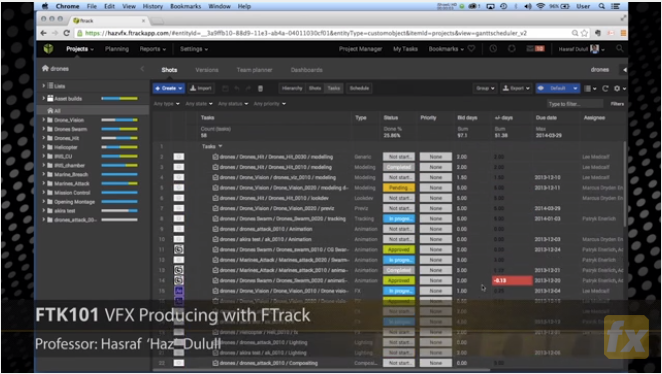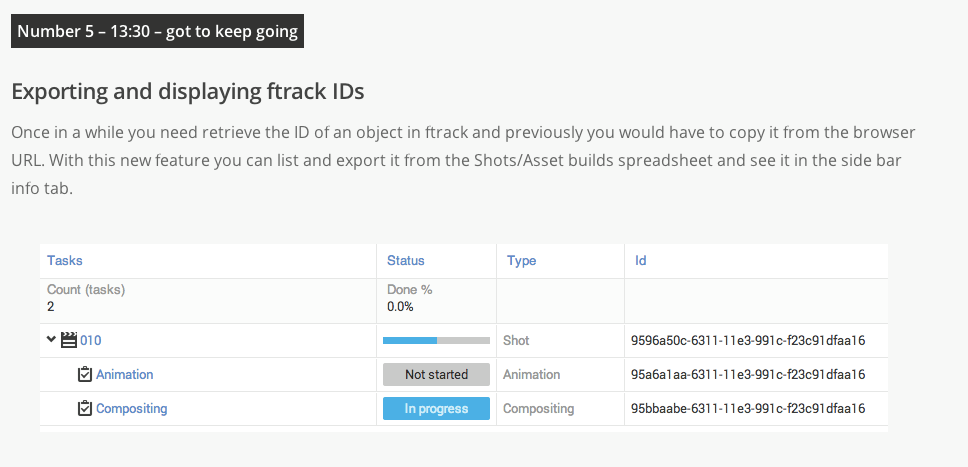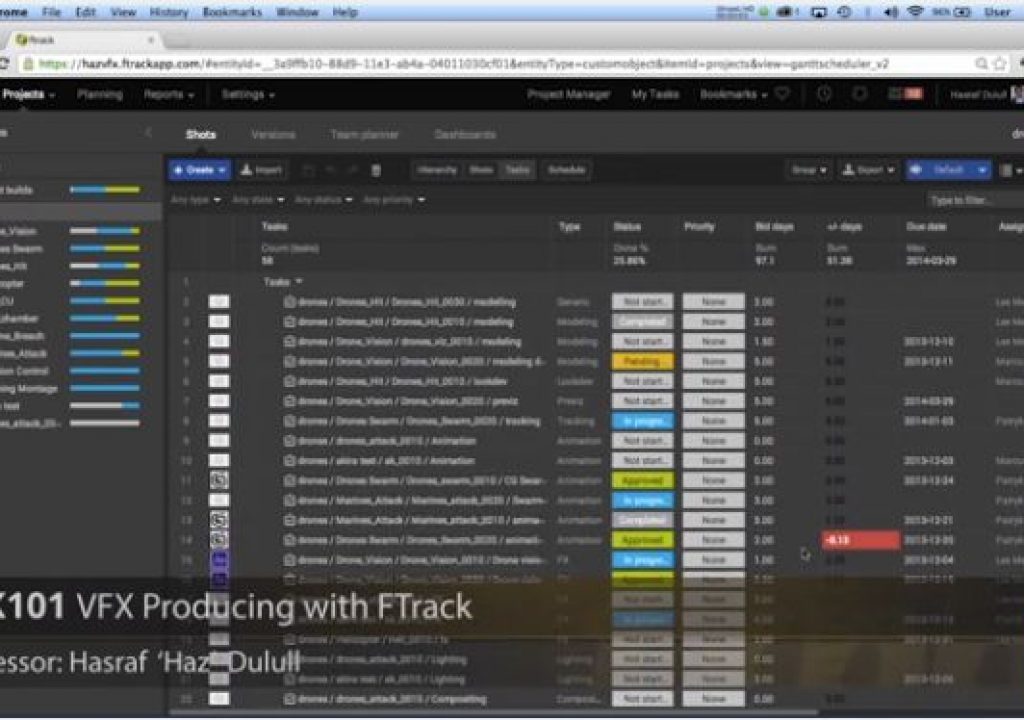Project management is an issue that industry professionals of all sizes and types deal with. Keeping track of shots, figuring out how to collaborate with someone who’s on the other side of the world and trying to organize budgeting and scheduling logistics are just a few of the issues that come up during production and post. The improper handling of these details can create delays that negatively impact budgets and cause projects to be delayed or even cancelled.
ftrack is a cloud based creative project management tool for Production Tracking, Asset Management and Team Collaboration. They’ve created a tool that is easy to work with and does everything needed in one integrated platform. The company has a number of big name clients utilizing their solution, including The Mill, MPC commercials, Lipsync, Cinesite, Digital Dimension, Zero VFX, Mackievision and Saddington Baynes, just to name a few.
 We wanted to talk through how project management has changed and how creators have utilized ftrack, so we sat down with ftrack CEO Fredrik Limsäter. He discusses how project management has evolved, how he’s seen projects affected by these sorts of decisions and what makes ftrack different from other project management tools.
We wanted to talk through how project management has changed and how creators have utilized ftrack, so we sat down with ftrack CEO Fredrik Limsäter. He discusses how project management has evolved, how he’s seen projects affected by these sorts of decisions and what makes ftrack different from other project management tools.
ProVideo Coalition: What are some common product management issues that you see people run into? Are they typically solved, or merely dealt with?
Fredrik Limsäter: Project management in VFX is really similar to project management in pretty much any industry. The added complexity is that people working in post-production, especially visual effects, are dealing with hundred of versions of shots, multiple artists working on similar things, and nothing to really keep track of it all.
How have you seen the approach to project management change and evolve?
As we are all aware of in visual effects, more competition worldwide has meant shrinking budgets, shorter delivery windows and greater expectations from clients. This can place a strain on facility resources and emphasizes the need to be as efficient as possible. Because of this, being able to plan a project as accurately as possible and then track and monitor the status of shots and jobs in process has become critical to ensure that all facets of a production are staying within the budget and the resources that have been assigned to it.
Has the fact that so many people are working remotely or in different locations changed the way people think about their project management?
Yes. Without doubt. Large facilities like The Mill and MPC that are using ftrack are operating across multiple locations and are able to collaborate on projects with artists and producers working around the clock to be able to turn work around quicker.
Do you think professionals who have project management issues have them because they’re trying to do too much, or because they’re not doing enough?
Projects have continued to become more complex over time. Greater expectations from clients can mean more people on a project, more softwares being used, more assets generated and often times distributed teams working together. The datasets and information demands have scaled dramatically so it’s more of a question of how to find a solution to managing all of this in a way that is purposefully built for our industry.

Tell us about a project that you’ve seen greatly impacted by an intelligent decision made around their workflow.
This past year we had a customer, Filmmore, be able to take 71 shots in 2 weeks time for a film project while they were booked at near capacity. By scripting their comp pipeline via ftrack, they were able to ingest plates and automate the creation of NUKE projects in terms of colorspace, aspect ratio and format size to allow for artists to start working immediately on shots without having to deal with the typical time and labor intensive shot set up process.
Let’s talk about your product, ftrack. What makes it different from other production management tools?
ftrack was developed as an in-house production management tool over 6 years ago at Fido in Stockholm. It has benefited from being a production-tested tool and was designed to originally handle the workflows for a mid-size to smaller facility. We emphasized ease-of-use and quick integration into existing workflows. A great deal of customization and scripting into one’s pipeline is possible, but ftrack allows for quick initial deployment and a plug-and-play experience for anyone using it for the first time.
What makes it worth investing in versus a free product like Googledocs?
ftrack is designed for the creative industry with a focus on how both artists and producers work and what is valuable to them. It’s based around an intuitive workflow that when used properly allows for a more efficient exchange of communication both internally and with the client in a format and terminology that is specific to our industry. It has features such as artist time logging when working on shots and client review/approval tools. Those are just some examples of functions that go well beyond what you can do in a more generalized free app. We are also a really cost effective solution starting at just $39 a month for the starter pack.
Are the tools designed for big production pipelines, or can a small team make use of the tools?
The platform is designed to appeal to the smaller teams with a philosophy of, “it should just work”. This approach coupled with a robust API has attracted many larger clients in film, commercials, marketing and design.

Is it just for visual effects, or can a filmmaker who just needs to keep track of everything that's going on utilize it?
ftrack is really a complete production management solution and covers everything from VFX shot management to budgeting to scheduling. So while its roots are built around the challenges of people working in visual effects, the rich functionality transfers across to anyone that working on a visually led project.
How does ftrack handle version management?
ftrack can track and manage published versions of assets and the dependencies between them. Currently, most of this takes place through the Python API and the integrations into popular applications. As well as tracking the data, ftrack can also take ownership of moving the data around and structuring it appropriately (directory structure, naming conventions etc.). Published data is typically linked to items in the production tracking part of the system as a way to make them more visible and provide additional context (e.g. this version was produced as a result of this task and so should be reviewed in the next dailies).
In ftrack, an Asset is a container for a bunch of AssetVersions. Each AssetVersion can contain one of more Components, with a Component typically being a representation of data (files) on disk. This allows for multiple types of files to be included in each version (for example, the rendered images and a preview movie of them). Each Asset has an AssetType which is a high level way to classify different types of assets and allow folks to differentiate between published versions easily (e.g. a model vs a rig or comp). Finally, an Asset can be linked to a Task, Shot or AssetBuild* for context.
*An AssetBuild typically refers to an abstract element in the script that might appear multiple times (for example a Character or Prop) and can be built independently of any particular shot.
 What kind of feedback do you most commonly hear from people who are using ftrack?
What kind of feedback do you most commonly hear from people who are using ftrack?
People really like the user experience that it offers. It’s designed to keep things really simple but to also give them the rich functionality they expect for complex projects.
Another element they like is the ability to get ftrack up and running really quickly. It can be used by a small team or one man band out of the box, and we have a free 30-day trial. There are lots of training materials, and larger facilities don’t need to do a lot of customization and set up to get it working in their pipeline.
Customers also find the support team very responsive and like the fact they they are often dealing directly with the development team. We like having that personal interaction with people, and believe it’s really key to our success.

Filmtools
Filmmakers go-to destination for pre-production, production & post production equipment!
Shop Now













